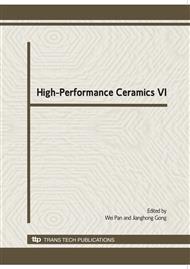p.21
p.24
p.28
p.33
p.37
p.42
p.45
p.48
p.50
Microstructure and Performance of the Hot-Pressed Silicon Nitride Ceramics with Lu2O3 Additives
Abstract:
The influence of Lu2O3 on phase transformation and seeds morphology was investigated. The result showed that the β-Si3N4 seeds with up to 95% β phase content could be obtained with 2wt% Lu2O3 as the additive content under 1750°C for two hours. The microstructure and mechanical properties of hot-pressed Si3N4 ceramics, using 9wt.% of Lu2O3• additives were investigated by the means of MTS measurements and Vickers indentation crack size measurements, as well as XRD and SEM. It was known that the high fracture toughness of Si3N4 ceramics was attributed to the rodlike morphology of β-Si3N4 grains. And the reinforcement effect and mechanism of β-Si3N4 seed were studied. It was found that the grain size and its distribution influence the property and microstructure of Si3N4 ceramics, namely, the relative narrow distribution of grain diameter in some extent and relative wide range of bimodal distribution of grain aspect ratio could improve the property of Si3N4 ceramics. The improvement in the fracture toughness with the amount of additive was mainly attributed to elongated grain growth during the sintering process.The high temperature properties of self-reinforced Si3N4 with different additives were studied. By this method, self-reinforced Si3N4 ceramics with an increment of 10~20 percent of fracture toughness was successfully fabricated.
Info:
Periodical:
Pages:
37-41
Citation:
Online since:
March 2010
Authors:
Keywords:
Price:
Сopyright:
© 2010 Trans Tech Publications Ltd. All Rights Reserved
Share:
Citation:


